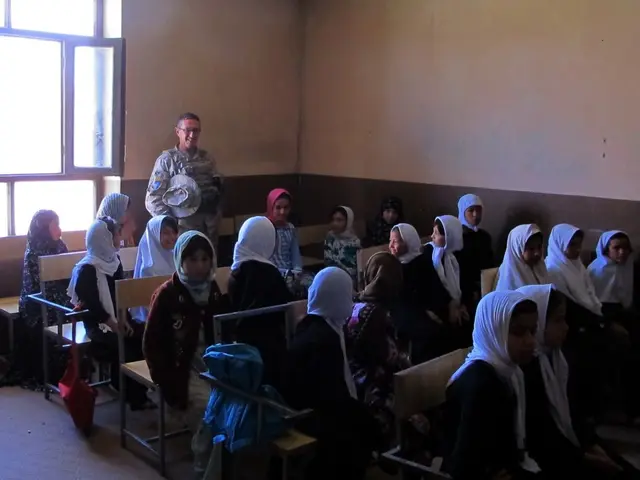Employees Working Full Shifts Remotely: Is the Truth being Upheld?
## Streamlining Remote Work: Strategies for Monitoring Employee Hours and Boosting Productivity
In the era of remote work, maintaining productivity and ensuring accountability can be challenging. Here's a comprehensive guide on employing technology, clear policies, and effective management practices to monitor remote employees' work hours effectively, while fostering a productive and trusting work culture.
### Embracing Technology
- **Time Tracking Software:** Utilize reliable time tracking tools that offer customizable timesheets, report generation, and mobile access. This enhances accuracy, reduces manual errors, and provides flexibility [4][5]. - **Active Time Monitoring:** Leverage tools like DeskTime to track active engagement by recording keyboard and mouse activity during work hours, offering insights into employees’ workloads and focus levels [3]. - **App and Website Usage Tracking:** Monitor which applications and websites employees use to identify productivity patterns and potential distractions without invasive surveillance [3][5]. - **Project and Progress Tracking:** Some platforms allow tracking of time spent on specific tasks or projects, offering visibility into output and ensuring alignment with deadlines [3]. - **Screenshot and Activity Logging:** Implement advanced systems, such as MaxelTracker, to take periodic screenshots (with privacy controls) to document progress, though this should be used with caution to avoid privacy concerns [2]. - **GPS Location Verification:** For field teams, GPS-based tracking can confirm employee locations, but this should be implemented transparently and with clear privacy policies [1].
### Best Practices for Implementation
- **Establish Clear Policies:** Develop and communicate clear guidelines for time tracking, including expectations for clocking in/out, breaks, and timesheet submission [4]. - **Set Remote Work Expectations:** Define working hours, availability, communication protocols, and productivity standards tailored for remote teams [4]. - **Provide Training and Support:** Ensure employees understand how to use tracking tools and address any concerns they may have about privacy or usability [4]. - **Balance Oversight and Trust:** Use monitoring tools to create accountability without micromanaging. Focus on results and productivity rather than constant surveillance [2][5]. - **Respect Privacy:** Be transparent about what data is collected, how it is used, and ensure compliance with privacy laws. Offer opt-outs or privacy controls where possible [1][2].
### Common Pitfalls to Avoid
- **Invasive Monitoring:** Overly intrusive methods (e.g., constant screenshots, location tracking without consent) can erode trust and morale [1][2]. - **Overemphasis on Activity vs. Output:** Tracking only activity or hours logged may not reflect true productivity. Combine these metrics with project outcomes and deadlines for a fuller picture [3]. - **Lack of Employee Buy-In:** Failure to communicate the purpose and benefits of monitoring can lead to resistance. Engage employees in the process and address their concerns proactively [4].
## Tools Comparison Table
| Feature | Example Tools | Use Case | Privacy Consideration | |-------------------------------|------------------------|---------------------------------------------|--------------------------------------| | Automated Time Tracking | Traqq, DeskTime | Accurate hour logging, payroll | High (can mask sensitive data) | | Activity/App Tracking | DeskTime, Traqq | Productivity insights, distraction analysis | Medium (app usage only) | | Screenshot Monitoring | MaxelTracker | Progress verification | High (requires strict controls) | | GPS Location Tracking | GPS-based apps | Field/remote location verification | High (transparency needed) | | Project/Progress Tracking | DeskTime, others | Deadline management, workload balance | Low (task-focused) |
## Key Takeaways
- **Leverage technology**—automated time tracking, activity monitoring, and project management tools—to gain visibility without micromanaging [3][4][5]. - **Communicate clearly**—set expectations, provide training, and be transparent about monitoring practices to maintain trust [4]. - **Focus on outcomes**—combine time tracking with productivity metrics and project deadlines to ensure quality work, not just logged hours [3]. - **Respect privacy**—balance oversight with employee autonomy, using privacy controls and clear policies to address concerns [1][2].
By integrating these strategies, organizations can effectively monitor remote employees’ work hours, enhance productivity, and minimize deadline issues—all while fostering a positive and trusting remote work environment. Additionally, observing employee behaviour such as emails and communication tool activity, timestamps on files and code can provide further insights into employees’ work patterns.
- Besides using remote employee monitoring tools like DeskTime for time tracking, active time monitoring, and app and website usage tracking to boost productivity, consider implementing project management tools like DeskTime to keep track of time spent on specific tasks or projects and ensure alignment with project deadlines.
- When incorporating screenshot and activity logging systems such as MaxelTracker into remote work practices, it's essential to establish clear privacy policies to avoid potential concerns and ensure compliance with privacy laws.
- In order to support personal growth and education-and-self-development amongst remote workers, encourage employees to make use of their free time during work hours for activities that foster such development, while also ensuring proper use of time and resources for work-related tasks.




